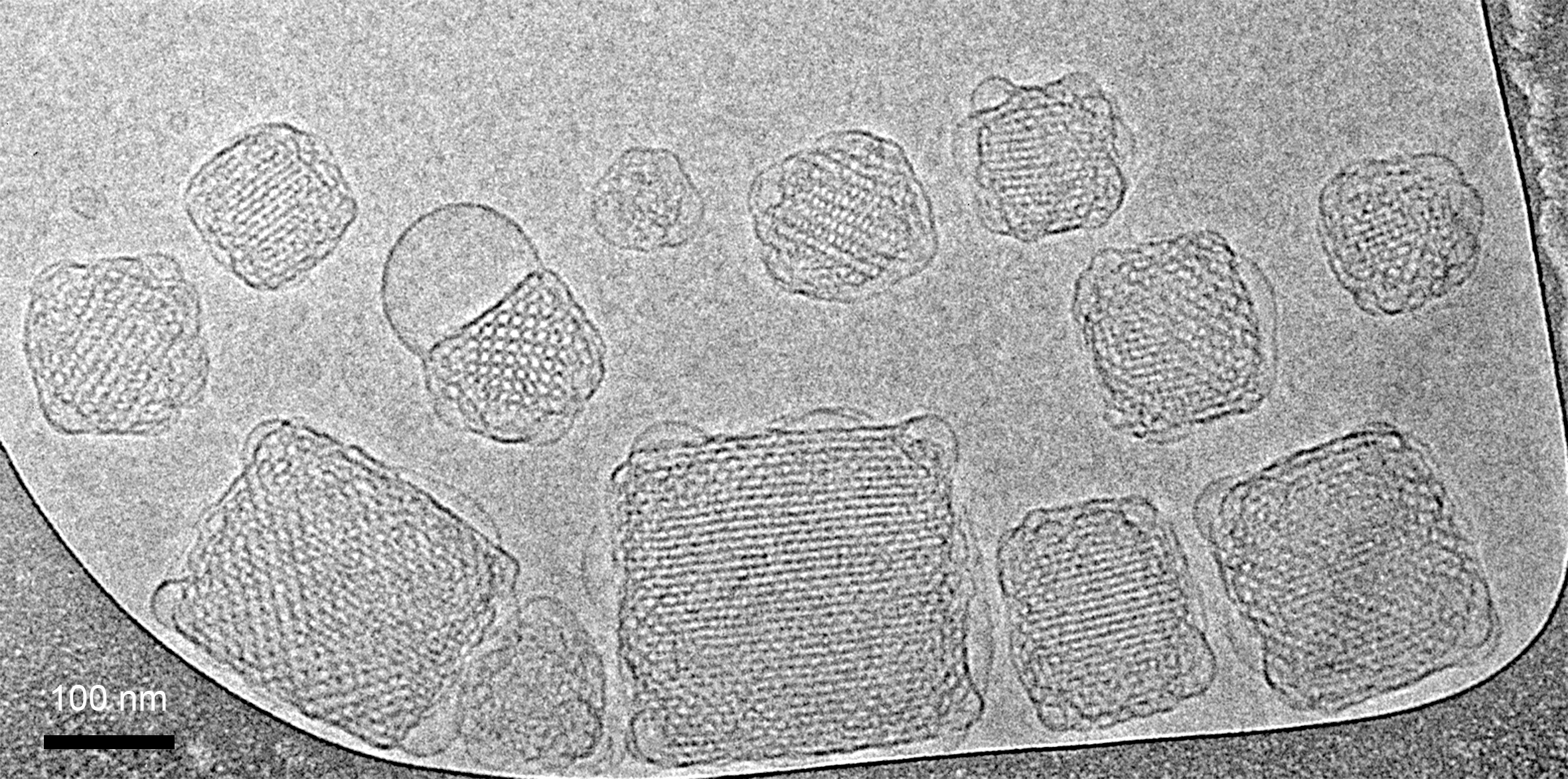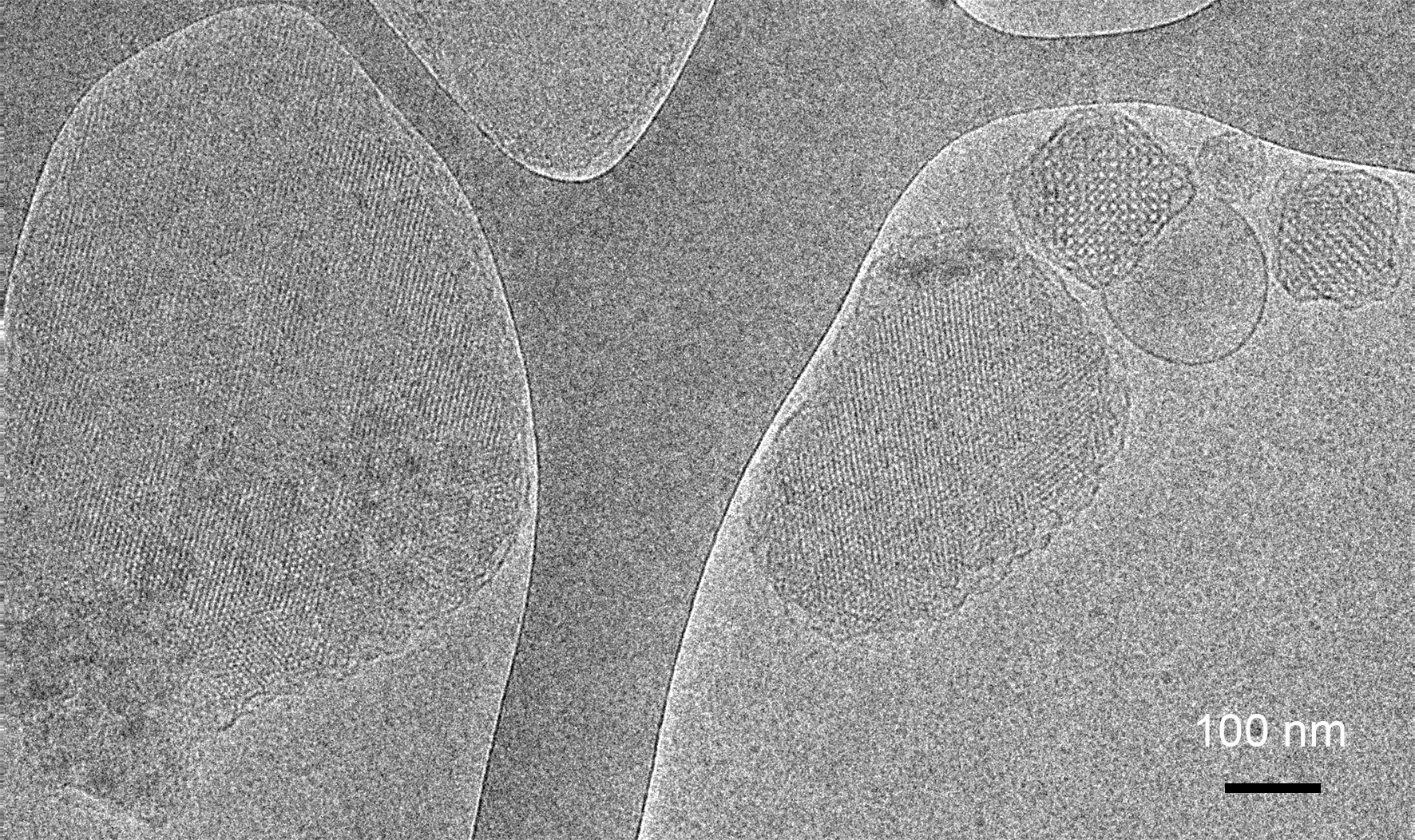For the first time ever scientists have added a pH-sensitive polymer to an unusual lipid that forms crystalline cubes (known as cubosomes) to transform it into a potential drug-delivery system. According to the recent publication in Soft Matter, the unique polymer significantly altered the nanostructure of the cubosomes at pH 5.5, which were visualised using cryo-transmission electron microscopy (cryo-TEM) and small-angle X-ray scattering (SAXS).
Monoolein is a monoglyceride that has recently attracted much attention for its potential application in drug delivery. It forms a lipid bilayer that can adopt an unusual cubic phase, and people have recently learnt how to extract sub-micron particles of these ‘cubes’ for study. The cubic particles are stable crystals of lipids that have intriguing properties as possible drug carriers, but to fully harness this potential, they need to be engineered to encapsulate and release their cargo.
A European collaborative effort oversaw the introduction of a novel pH-sensitive polymer into the cubosomes in an effort to make them responsive to physiological triggers. Cryo-TEM and SAXS were used to visualise the cubic particles in neutral and acidic pHs. In the presence of the novel polymer, a low pH disrupted the nanostructure of the cubosomes, which would liberate any would-be drugs. This remarkable finding could be just the beginning of the drug delivery journey for cubosomes.

Figure 1: Cyro-TEM micrographs of the system at pH 7.5.
Magic lipid
Monoolein has been hailed as a ‘magic lipid’ for its advantageous properties that make it highly applicable for drug delivery. Notably, it forms a lipid bilayer that adopts a well-ordered cubic structure, plus it is also biocompatible as it is derived from natural materials. However, to fully realise its potential as a substance that can encapsulate and release drugs, it needs to be fine-tuned to respond to physiological triggers.
Via a European Commission funding initiative (Innovative Training Network), scientists with a shared interest in studying monoolein were brought together from the University of Strasbourg, Imperial College London and the University of Leeds. Together they sought to adapt monoolein to make it more suited to being a drug carrier.
A member of the collaboration, Dr Fabrice Thalmann, Assistant Professor at the University of Strasbourg, summarised the main aims of the project: “Our objective was to make these cubosomes pH-responsive, so that they could change their structure by means of changing the pH conditions. This cannot occur with the lipid molecules alone, so we needed to incorporate a pH-active molecule into the structure, with the structure keeping the same stable cubic organisation.”

Figure 2: Cyro-TEM micrographs of the system at pH 5.5.
Sensitive to pH
A member of the team from Imperial College synthesised a pH-responsive polymer known as PP50 and this was mixed with commercially available monoolein. The samples were analysed at pH 7.5 and pH 5.5 using both cryo-TEM (at the University of Strasbourg) and SAXS at the I22 beamline here at Diamond Light Source.
Dr Thalmann explained why they used SAXS at Diamond: “We needed to show the crystalline organisation, but because the cubic lattice sizes were large and our samples were dilute, we needed to go to quite low scattering angles, which necessitated synchrotron light.”
The team saw that the introduction of PP50 did not affect the cubic structure of monoolein at pH 7.5, but there was a notable effect at pH 5.5: “The polymer changed the organisation of the cubic particles and made it sensitive to pH conditions. Such a strong effect induced by pH is very novel,” explained Dr Thalmann. This structural disturbance could liberate any potential drugs that might be encapsulated within the cubes.
Acidic drug-release
The potential acidic drug-release mechanism shown by the team could hopefully be exploited by the endosomal pathway in human cells. “It is a natural mechanism by which cells engulf molecules and process them at a lower pH within endosomes. At the lower pH the molecules will become active and release their cargo to target the cells,” stated Dr Thalmann.
This is the first time that cubosomes have been adapted in this way, so the study has opened up an avenue of further work. The team want to continue exploring the effect of the polymer on the cubosomes to understand the exact structure that results at pH 5.5 and to analyse the kinetics of this disruption. The boundary at the edges of the cubosomes is also of interest, so this may be explored.
The possibilities are almost limitless, and various combinations of different lipids and polymers might unlock the full potential of this novel drug delivery technique.
To find out more about I22, or to discuss potential applications, please contact Dr Nick Terrill: nick.terrill@diamond.ac.uk
Kluzek M et al. Influence of a pH-sensitive polymer on the structure of monoolein cubosomes. Soft Matter 2017; 13: 7571–7577.
Diamond Light Source is the UK's national synchrotron science facility, located at the Harwell Science and Innovation Campus in Oxfordshire.
Copyright © 2022 Diamond Light Source
Diamond Light Source Ltd
Diamond House
Harwell Science & Innovation Campus
Didcot
Oxfordshire
OX11 0DE
Diamond Light Source® and the Diamond logo are registered trademarks of Diamond Light Source Ltd
Registered in England and Wales at Diamond House, Harwell Science and Innovation Campus, Didcot, Oxfordshire, OX11 0DE, United Kingdom. Company number: 4375679. VAT number: 287 461 957. Economic Operators Registration and Identification (EORI) number: GB287461957003.